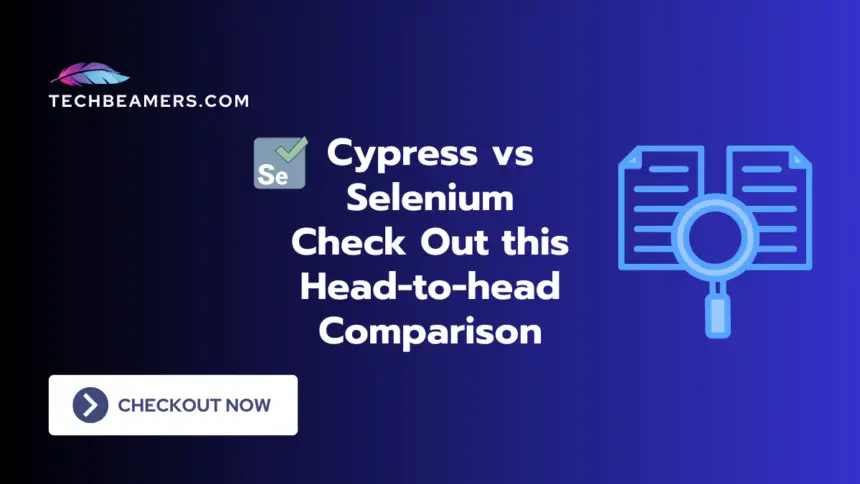Welcome friends to this short guide to tell you about the difference between Cypress vs Selenium. In this tutorial, we’ll focus only on the main points to help you understand whether should you use Cypress or Selenium.
Cypress and Selenium are both popular tools for automating web application testing, but they have some key differences: Let’s understand this topic in a bit more detail.
Cypress vs Selenium – Understand the Differences
Let’s first check out some background of both these automation testing tools.
| Cypress | Selenium |
|---|---|
| Cypress is an open-source end-to-end testing framework designed for modern web applications. It is built using JavaScript and is specifically crafted to make it easier for developers and QA engineers to write and run tests for their web applications. Here are some key points about Cypress and its background: | Selenium is a widely used open-source framework for automating web browsers. It provides a suite of tools and libraries for automating browser interactions, making it a popular choice for web application testing and browser automation. Here are some key points about Selenium: |
| Introduction: Cypress was created by Brian Mann and Drew Lanham, and the project was initially released in 2014. It gained significant popularity in the web development and testing community due to its unique architecture and ease of use. | Origin and History: Selenium was originally developed by Jason Huggins in 2004 at ThoughtWorks as an internal tool for testing web applications. The project was later open-sourced, and Selenium WebDriver, a major component of Selenium, became the primary focus for web automation. |
In order to draw a comparison, we have to consider certain parameters which are provided below for your reference.
1. Architecture
Cypress:
- Cypress runs directly in the browser alongside the application being tested.
- It is a JavaScript-based end-to-end testing framework.
- Cypress has a more tightly integrated architecture, allowing it to have better control over the browser environment.
Selenium:
- Selenium is a suite of tools and libraries that allows automation of web browsers.
- It uses a client-server architecture where the Selenium WebDriver communicates with the browser through a separate driver.
- Selenium supports multiple programming languages, including Java, Python, C#, Ruby, etc.
2. Browser Support
Cypress:
- Primarily focused on supporting modern browsers like Chrome and Firefox.
- Limited support for Internet Explorer and Edge.
Selenium:
- Supports a wide range of browsers, including Chrome, Firefox, Safari, Internet Explorer, and Edge.
3. Testing Capabilities
- Cypress:
- Primarily designed for end-to-end testing and integration testing.
- Offers a built-in way to stub and spy on network requests.
- Selenium:
- More versatile and can be used for various testing levels, including unit testing, functional testing, and acceptance testing.
- It has a wide range of third-party tools and libraries for different testing needs.
4. Ease of use
- Cypress: Generally considered easier to learn and use due to its simple setup, intuitive API, and extensive documentation.
- Selenium: More complex setup and requires knowledge of programming languages like Java or Python. Can be daunting for beginners.
Speed:
- Cypress: Runs tests directly in the browser, making it significantly faster than Selenium. This is great for fast feedback loops during development.
- Selenium: Relies on external drivers, which can slow down test execution.
5. Supported languages
- Cypress: Only supports JavaScript.
- Selenium: Supports multiple languages like Java, Python, JavaScript, C#, etc. This makes it more versatile for teams with varied skill sets.
Features:
- Cypress: Offers features like automatic waiting, time travel debugging, and real-time reloading, which improve developer experience.
- Selenium: Offers more advanced features like parallel testing, mobile testing, and API testing.
6. Browser support
- Cypress: Does not support Safari (WebKit engine).
- Selenium: Supports all major browsers through different drivers.
Head to Head Comparision Between Cypress vs Selenium
Here’s a table summarizing the key differences:
| Feature | Cypress | Selenium |
|---|---|---|
| Ease of use | Easier | Harder |
| Speed | Faster | Slower |
| Supported languages | JavaScript only | Java, Python, JavaScript, C#, etc. |
| Features | Developer-friendly features | More advanced features |
| Browser support | All except Safari | All major browsers |
How to Choose Between Cypress vs Selenium
Choosing between Cypress and Selenium depends on your specific needs:
- Use Cypress if:
- You are a beginner or prefer a simple and fast tool.
- Your team primarily uses JavaScript.
- You prioritize developer experience and quick feedback loops.
- Use Selenium if:
- You need to test across multiple languages or platforms.
- You require advanced features like parallel testing or mobile testing.
- You need robust support for all major browsers.
Ultimately, both Cypress and Selenium are powerful tools with their own strengths and weaknesses. Choose the one that best fits your testing needs and skillset.
We hope this explanation is simpler! Let me know if you have any further questions.









